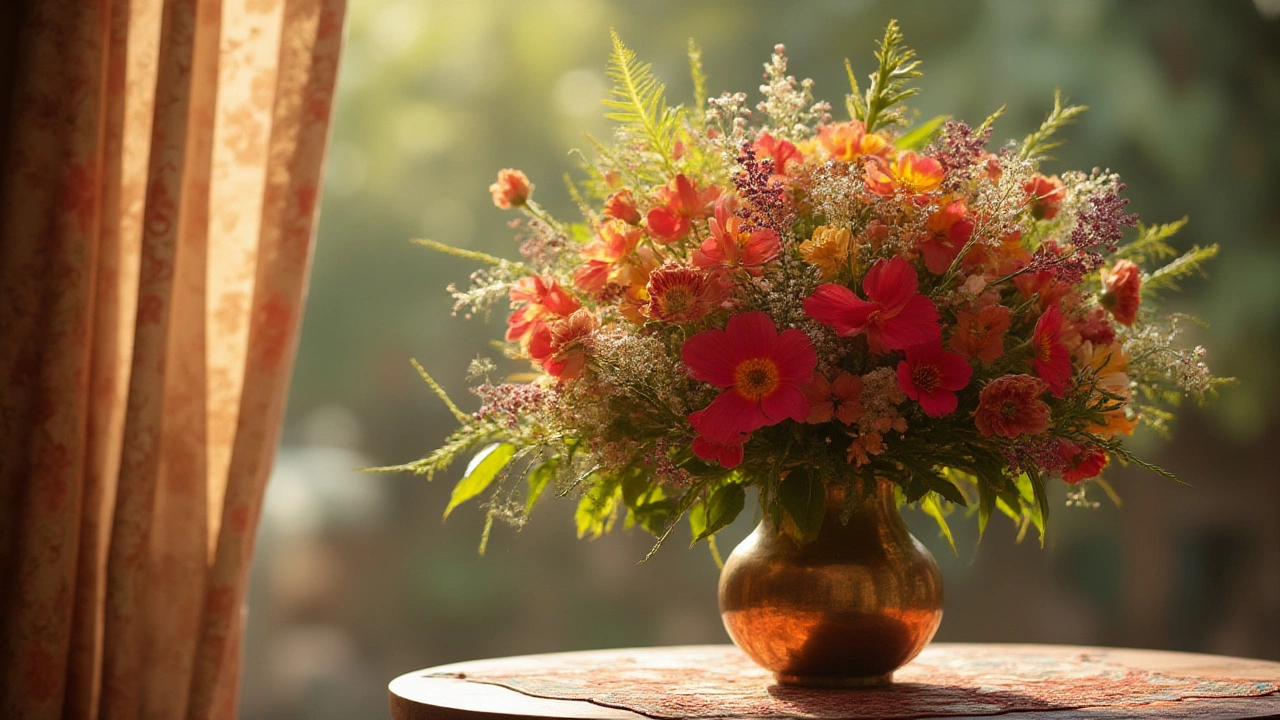Who wouldn’t want a garden that throws a party every month of the year? Imagine stepping outside in December and still seeing splashes of colour among the gloom. But here’s the kicker—most flowers have their diva moments and sulk for the rest of the year. The quest to find which flowers truly bloom all year round is a rabbit hole for any green-fingered soul. There’s folklore about magical blooms, but what’s fact and what’s fantasy? Some gardeners swear by certain perennials. Others paint wild tales of unyielding geraniums. If you’re dreaming of a never-ending flower show, stick with me—we’ll cut through the hype and get real about which flowers keep the promise of non-stop blooms, even in the unpredictable UK weather.
Understanding Year-Round Bloomers: Myths and Truths
Right, let’s start straight with the facts. No true flower in the UK garden blooms every single day, all year, without so much as a pause. Even the hardiest perennials need a breather after throwing out blooms for months. However, there are some impressive plants that can make your garden feel alive almost 365 days—thanks to staggered blooming cycles, clever plant combinations, and a touch of gardening tricks. What most people mean by "year-round flowers" are plants that either flower repeatedly or varieties from a group that, combined, can ensure blooms every month.
Take the humble pansy, for instance. While a single bloom won’t last the entire year, sowing different varieties at key points can keep colour popping from autumn through spring. Or how about the reliable winter-flowering heather (Erica carnea)? Its vibrant pinks and purples kick off just as many gardens go quiet, and it will soldier on well into spring. Of course, in the frostiest days, even these champions might take a brief nap, but they come as close as any real flower gets to year-round colour.
Then there’s the old favourite—the geranium (Pelargonium). In a greenhouse, they’ll flower practically non-stop. Outdoors, especially in Manchester’s chill, these beauties need a warm spot and frost protection to keep going. And let’s not forget the classic rose. Some modern shrub roses pump out fresh blooms from May until the first real frost. The trick is picking repeat-flowering varieties, like the David Austin English roses, which surprise with wave after wave.
For those tempted by all the houseplant hype, African violets (Saintpaulia) can actually pull off near-constant flowers on a sunny indoor windowsill. Newer varieties pump out flowers for much of the year, as long as you keep them snug and fuss-free. In short, the year-round bloom dream is achievable—with clever plant choices, a pinch of patience, and the willingness to mix indoors and out.
Here’s a quick look at what “year-round bloom” actually means—do you want a single bloom that never dies (impossible), or a living, ever-changing display where different blooms pick up the baton as the months pass? The most reliable approach, as any honest gardener will tell you, is to choose a mix of perennials and annuals that between them ensure your garden is never fully asleep. Think of it like putting together a relay team rather than expecting one runner to do the whole marathon alone.
Top Flowers for Non-Stop Blooms—Garden Champions
Alright, time to get practical. Which flowers deliver the goods when it comes to near year-round colour? You want champions, not wallflowers. Here’s a tried-and-true line-up, with notes from personal experience and trusted garden sources across the UK:
- Primrose (Primula vulgaris): Brave enough for cold spells, some wild primroses bloom long into winter and start again early spring. There’s even the fancy polyanthus primrose that covers autumn to late spring if you deadhead spent blooms.
- Pansy (Viola tricolor): Those winter-flowering pansies are perfect in containers and borders from autumn right through to the warmer months. Mixed colours, cheerful faces—just don’t let them dry out in summer.
- Erica carnea (Winter heath): Nothing is more reliable in the bleak months. Hardy as nails, this little shrub delivers pinks and reds from November to April.
- Hellebore (Christmas rose): These shade-loving wonders come alive in late winter and hold on for months with large blooms in whites, pinks, and purples.
- Geranium (Pelargonium): Indoors or under glass, you’ll get more or less non-stop flowers. Outside, they need protection, but a heated porch or conservatory keeps them firing.
- Calendula (Pot Marigold): Sow in spring, and you’ll often find this flower self-seeds and keeps blooming even in the mildest winters.
- Roses (Repeat-blooming varieties): Invest in reputable cultivars like Rosa ‘Flower Carpet’ or David Austin’s repeaters, and you’ll be snipping blooms from May until the first hard frost.
- African violet (Saintpaulia): A warm windowsill and some TLC reward you with almost constant flowers indoors.
- Kaffir lily (Clivia miniata): Indoors in the UK, these tropicals offer an orange burst throughout winter and spring.
- Impatiens (Busy Lizzie): In a frost-free conservatory or under glass, these can do a near year-long show.
- Fuchsia (Hardy types): Choose ‘Riccartonii’ or similar for months of blooms from late spring right through to frost. Prune and mulch well against winter cold.
This isn’t even the full list—once you’ve mastered these, you’ll start inventing your own combinations. Remember, location is king: what blooms nonstop in the south might quit early up north unless you give it protection. Microclimates—like sheltered patios or sunny borders—can trick even the fussiest plants into a longer show.

Essential Tips to Keep Your Garden in Constant Bloom
So you’ve picked your squad of non-stop bloomers. Next, let’s talk about keeping them at their best. Because even the toughest plants can flag if you don’t give them a bit of attention. Here’s how you keep the flowers coming regardless of Manchester drizzle or a cold snap.
- Deadheading: Snip off faded blooms before they set seed. This makes the plant send out more flowers, trying to finish the job.
- Feed and mulch: Whether it’s organic chicken pellets or a good liquid feed, don’t starve your plants. Add a thick mulch in autumn to keep roots warm and hungry slugs at bay.
- Right plant, right place: Don’t expect sun-loving blooms like lavender to thrive in shade. Read plant labels and match to your sun/shade situation for bigger, longer bloom.
- Winter protection: Many so-called ever-bloomers will keep going longer with even simple steps—cover with fleece on cold nights, move pots to sheltered zones, or grow under glass.
- Succession planting: Layer your garden. Have snowdrops for January, daffodils for March, wallflowers in April, roses from May, dahlias all summer, and hardy fuchsias and heathers for winter. It’s a relay!
- Watering: Consistent moisture is the magic. Most bloomers hate drying out but don’t drown them either—balance is everything.
- Pest Patrol: Slugs, aphids, and vine weevil are the usual party-crashers. A weekly check and natural solutions—like nematodes or coffee grounds—go a long way.
- Indoor-Outdoor Mix: Don’t limit yourself to just the flowerbed. African violets, clivias, even some orchids can keep your windowsill busy while your outdoor blooms rest.
Of course, not all flowers are created equal. Some, like pansies and heather, are tough as boots. Others—orchids, geraniums—prefer a little shelter in the colder months. But mix enough of them, pay attention to their signals, and you’ll have something showing colour, even in mid-January when neighbours’ gardens are all mud and misery. And don’t get discouraged if a harsh winter cuts the display short. Next season, try a different combo and you’ll get closer to the dream of year-round blooms.
Data, Stats, and Real Garden Results: What to Expect
Let’s get real—what does all this effort look like in numbers? The big names in UK gardening, from BBC Gardeners’ World to the Royal Horticultural Society, agree on some reliable stats. Here’s a quick snapshot, based on reports from both home gardeners and formal trials:
| Flower | Months in Bloom (UK average) | Hardiness (Down to °C) | Indoor/Outdoor |
|---|---|---|---|
| Pansy | October to June (up to 9 months) | -10 | Outdoor |
| Primrose | December to May (6-7 months) | -20 | Outdoor |
| Winter Heath (Erica carnea) | November to April (5-6 months) | -15 | Outdoor |
| Geranium (Pelargonium) | Year-round (with greenhouse) | 0 | Indoor/Glasshouse |
| African Violet | Year-round (warm windowsill) | Not frost tolerant | Indoor |
| Calendula | March to December (up to 10 months) | -5 | Outdoor/Indoor |
| Rose (repeat-flowering) | May to November (up to 7 months) | -18 | Outdoor |
| Fuchsia (hardy) | May to October (6 months) | -10 | Outdoor |
If you layer these selections and add specials like Hellebores (flowering in January) and Snowdrops (February), you can keep the show going even here in Manchester. One real-life tip: if you’ve got a cold, shaded corner where nothing seems to bloom, pop in some cyclamen for autumn and watch your neighbours go green with envy.
To wrap things up, the key to success is choosing plants with overlapping seasons and not putting all your eggs in one basket. Don’t trust claims that any plant truly blooms every day, unless you’re growing silk or plastic. But build a mix, get to know your patch of the world, and you’ll surprise yourself with the display. Gardening is half art, half science, and all about patience. But when the first primrose peeks out next December, you’ll be glad you put in the effort for that year-round bloom dream.

